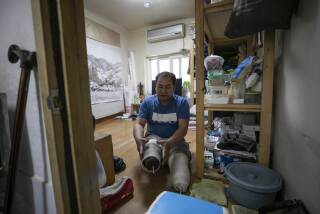Journalistic Drama Began With a Disputed Claim by Bush
The court hearing that resulted in New York Times reporter Judith Miller being sent to jail and Time magazine reporter Matthew Cooper agreeing to testify before a federal grand jury stemmed from a 2-year-old dispute related to President Bush’s claim that Iraq possessed weapons of mass destruction.
Question: How did the case get started?
Answer: In July 2003, several Washington-based reporters were following up on statements by former U.S. envoy Joseph C. Wilson IV. The retired diplomat had written a newspaper article accusing Bush of “misrepresenting the facts” when Bush suggested that Iraqi President Saddam Hussein, before he was ousted in the U.S.-led war, had sought uranium from Niger for atomic weapons. Wilson had been sent to the West African country by the CIA in 2002 to investigate an Iraq connection, but found no evidence to support one. In an apparent attempt to discredit Wilson, unnamed government officials told reporters that he had been recommended for his CIA assignment by his wife, Valerie Plame, who was identified as a CIA operative.Q: Was a crime committed?
A: By identifying Plame to journalists — including syndicated columnist Robert Novak, who disclosed her identity in his column — the government officials may have violated the Intelligence Identities Protection Act. The 1982 law makes it a federal crime to intentionally reveal the status of an undercover agent.Q: Is it easy to prove such an offense?
A:
No. Those familiar with the case say Plame may not have been a truly covert agent. Her employment with the CIA was known to some, and she worked in the Washington area, not in a foreign country. To obtain a conviction, prosecutors must prove that the perpetrator revealed the agent’s identity knowing that the United States had taken “affirmative measures to conceal the agent’s intelligence relationship with the United States.” The government would also have to prove that the leaker had reason to believe the disclosure “would impair or impede U.S. foreign intelligence activities.”Q: Are there other possible charges?
A:
Lawyers who have followed the investigation say it is possible that special prosecutor Patrick J. Fitzgerald may be investigating possible perjury or obstruction-of-justice allegations against officials who falsely denied talking to reporters.Q: Who is the special prosecutor and how did he get his job?
A:
Patrick J. Fitzgerald is the U.S. attorney in Chicago who gained acclaim prosecuting mobsters in New York. A Republican, he has used his post in Illinois to prosecute officials from both political parties. Deputy Atty. Gen. James Comey appointed Fitzgerald, 44, to the special prosecutor position after Novak disclosed Plame’s identity in his column on July 14, 2003. Then-Atty. Gen. John Ashcroft had recused himself in the matter to remove the appearance of a conflict of interest that could come from a Bush appointee directing an investigation of members of his own administration.Q: Why did Fitzgerald subpoena Miller and Cooper?
A:
The New York Times and Time magazine reporters, and other journalists ordered to testify, acknowledged speaking to sources about the Plame matter. Fitzgerald has said the only missing pieces in the investigation are interviews with Miller and Cooper. They potentially could corroborate who revealed Plame’s identity. Cooper wrote about the Plame issue for the Time website. Miller never wrote about the topic.Q: Why did the reporters face jail time?
A:
Both Cooper and Miller declined to discuss the matter with the special prosecutor, saying they had promised their sources confidentiality. Fitzgerald asked U.S. District Judge Thomas F. Hogan to hold the reporters in contempt of court. Hogan cited both Miller and Cooper for contempt in October. The contempt finding could keep Miller in jail for four months, the remaining term of the grand jury impaneled to investigate the matter.Q: Other journalists, including Novak, talked to government sources about Plame. Why haven’t they been threatened with contempt?
A: Other reporters spoke to the special prosecutor. They said they did so because their sources agreed that their names no longer had to be kept secret. Although Novak has declined to discuss the matter, it is believed that he probably spoke to Fitzgerald and the grand jury after his sources cleared him to do so.
Q: Administration officials signed agreements saying that reporters were free to reveal their identities. Despite that, why won’t reporters name their sources?
A: Miller, Cooper and other reporters say such “blanket waivers” are not truly voluntary. Officials may have signed them fearing that, if they didn’t, they could be punished or fall under suspicion. Cooper and other journalists said they would talk about their sources only after being convinced that the officials’ willingness to be identified was voluntary, not coerced.
Q: Who are the sources behind the Plame story?
A: Some of the journalists involved in the story, including Cooper, identified Lewis “Scooter” Libby, Vice President Dick Cheney’s chief of staff, as one of their sources after Libby gave them permission to do so. Walter Pincus of the Washington Post said, however, that Libby never raised Plame’s name. It has also been revealed that Cooper spoke to Karl Rove, senior advisor to Bush, the week before the Plame revelation. But the content of the conversation remains unknown. Rove’s lawyer insists that he “has never knowingly disclosed classified information,” and the advisor has not been named as a target of the investigation.
More to Read
Start your day right
Sign up for Essential California for news, features and recommendations from the L.A. Times and beyond in your inbox six days a week.
You may occasionally receive promotional content from the Los Angeles Times.







